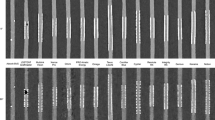Abstract
Purpose
Interventional cardiology devices and especially stents are constantly evolving. A good radiopacity is essential to properly position the stent and to reduce the risk of complications during percutaneous coronary intervention (PCI). We wanted to assess the radiopacity of coronary stents.
Methods
9 stents were evaluated. Stents were deployed in a silicon bifurcation model and several pulsed fluoroscopy acquisitions (7.5 and 15 pulses/s) of each device were performed in a catheterization laboratory. Quantitative radiopacity assessment was performed using a radiopacity visual scale and qualitative radiopacity assessment was performed by showing the images to three experienced operators, single-blind.
Results
Our study showed statistically significant differences between stents regarding radiopacity assessed in a quantitative analysis (p < 0.000001) or a qualitative analysis (p < 0.000001), whether the acquisitions were made in 7.5 or 15 pulses/s. Resolute Onyx and Synergy were the most radio-opaque in both qualitative and qualitative analysis. Moreover, there was a statistically significant correlation between the radiopacity of stents, their strut thickness (p < 0.0001) and the presence of platinum in their metallic alloy (p < 0.0001).
Conclusion
This study highlighted significant differences in the radiopacity of coronary stents deployed in a bench test model. The strut thickness and the presence of platinum increased the radiopacity.






Similar content being viewed by others
References
Bonin, M., P. Guerin, J. M. Olive, F. Jordana, and F. Huchet. Standardized bench test evaluation of coronary stents: biomechanical characteristics. Catheter Cardiovasc. Interv. 92(7):E465–E470, 2018.
Duda, S. H., J. Wiskirchen, G. Tepe, et al. Physical properties of endovascular stents: an experimental comparison. J. Vasc. Interv. Radiol. 11(5):645–654, 2000.
Finet, G., M. Gilard, B. Perrenot, et al. Fractal geometry of arterial coronary bifurcations: a quantitative coronary angiography and intravascular ultrasound analysis. EuroIntervention. 3(4):490–498, 2008.
Foin, N., R. Torii, E. Alegria, et al. Location of side branch access critically affects results in bifurcation stenting: insights from bench modeling and computational flow simulation. Int. J. Cardiol. 168(4):3623–3628, 2013.
Jorge, C., and C. Dubois. Clinical utility of platinum chromium bare-metal stents in coronary heart disease. Med. Dev. (Auckl). 8:359–367, 2015.
Lee, R. T., A. J. Grodzinsky, E. H. Frank, R. D. Kamm, and F. J. Schoen. Structure-dependent dynamic mechanical behavior of fibrous caps from human atherosclerotic plaques. Circulation 83(5):1764–1770, 1991.
Menown, I. B. A., R. Noad, E. J. Garcia, and I. Meredith. The platinum chromium element stent platform: from alloy, to design, to clinical practice. Adv. Ther. 27(3):129–141, 2010.
Wiesinger, B., A. Stütz, J. Schmehl, G. Groezinger, C. D. Claussen, and J. Wiskirchen. Comparison of visibility for four self-expanding nitinol bare stents in vitro. Acta Radiol. 53(9):1020–1025, 2012.
Wiskirchen, J., K. Kraemer, C. König, et al. Radiopacity of current endovascular stents: evaluation in a multiple reader phantom study. J. Vasc. Interv. Radiol. 15(8):843–852, 2004.
Wiskirchen, J., R. Venugopalan, A. D. Holton, et al. Radiopaque markers in endovascular stents–benefit and potential hazards. Rofo. 175(4):484–488, 2003.
Author information
Authors and Affiliations
Contributions
All authors have contributed to this manuscript.
Corresponding author
Ethics declarations
Conflict of interest
The authors declare that they have no conflict of interest.
Additional information
Associate Editor Gautam Kumar oversaw the review of this article.
Publisher's Note
Springer Nature remains neutral with regard to jurisdictional claims in published maps and institutional affiliations.
Rights and permissions
About this article
Cite this article
Piriou, PG., Guérin, P., Bonin, M. et al. Radiopacity of Coronary Stents, an In Vitro Comparative Study. Cardiovasc Eng Tech 11, 719–724 (2020). https://doi.org/10.1007/s13239-020-00492-w
Received:
Accepted:
Published:
Issue Date:
DOI: https://doi.org/10.1007/s13239-020-00492-w




